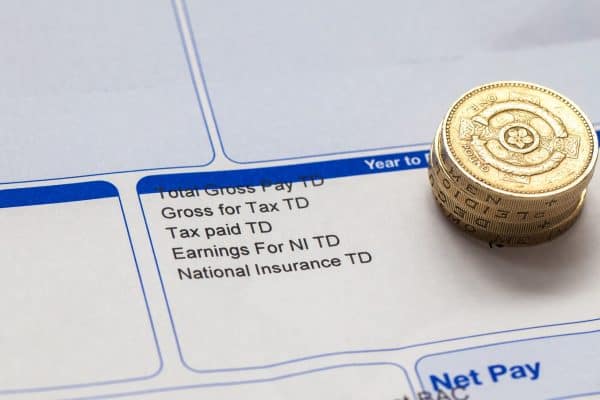If you earn money in the UK, you’ll likely see deductions for income tax and National Insurance on your payslips. We accept them as a given, rarely question what we pay, and perhaps some may even resent paying them a little bit. But how much do you really know about your deductions, and what they pay for?
What’s the difference between tax and National Insurance?
Tax and National Insurance work in similar ways. They’re both deducted directly from your wages before they hit your bank account. They also both pay for public services and state benefits. But, there are some key differences, too.
While income tax is calculated based on your total income, National Insurance is calculated and charged per job you have. So, if you work a number of part-time jobs, or have a full-time “day job” and are self-employed at the same time, you’ll pay multiple lots of National Insurance. There are also different classes of National Insurance payable if you’re employed, self-employed, or both. You can even make voluntary National Insurance contributions.
The other main difference between income tax and National Insurance is who has to pay it. You pay tax on any income you make, from any source, that exceeds the thresholds laid out by the government. National Insurance, on the other hand, is only charged to people of certain ages: between 16 and the state retirement age. National Insurance also only applies to your earned income, so you don’t have to pay National Insurance on income you receive from investments or interest on savings.
Tax and National Insurance are also used differently by the Treasury.
Read more: How to read your monthly payslip
What do my National Insurance contributions pay for?
National Insurance contributions mainly help to build your entitlement to state benefits, like Statutory Sick Pay (or SSP), Maternity Allowance, and particularly, the State Pension.
To be entitled to the full State Pension, you need to have made National Insurance contributions for 35 years. These don’t have to be consecutive years, so you won’t be penalised if you take a break from work. For example, maybe you’ve taken a couple of years off look after your child. You do need to have 35 years’ worth when you retire, though. If you don’t, then the pension you’re entitled to reduces proportionally in line with the number of years of National Insurance contributions you have made. If you haven’t contributed enough over the years, that’s where voluntary contributions come in – you can opt to pay more in a lump sum, or a series of lump sums, to top up your contributions, rather than take a smaller State Pension.

Monkey Business Images/Shutterstock
National Insurance contributions also go towards paying for other state services, like the NHS, unemployment benefits, and allowances for those with disabilities or long-term illnesses.
How much is National Insurance?
Knowing how much you’ll pay for this tax is based on how much you earn, and how you earn it. For those in employment, the breakdown is as follows:
| Category letter | £123 to £242 (£533 to £1,048 a month) | £242.01 to £967 (£1,048.01 to £4,189 a month) | Over £967 a week (£4,189 a month) |
| A | 0% | 8% | 2% |
| B | 0% | 1.85% | 2% |
| C | N/A | N/A | N/A |
| D | 0% | 2% | 2% |
| E | 0% | 1.85% | 2% |
| F | 0% | 8% | 2% |
| H | 0% | 8% | 2% |
| I | 0% | 1.85% | 2% |
| J | 0% | 2% | 2% |
| K | N/A | N/A | N/A |
| L | 0% | 2% | 2% |
| M | 0% | 8% | 2% |
| N | 0% | 8% | 2% |
| S | N/A | N/A | N/A |
| V | 0% | 8% | 2% |
| Z | 0% | 2% | 2% |
Source: https://www.gov.uk/national-insurance-rates-letters
To break this down into layman’s terms, a category A person with £1000 a week in earnings would pay nothing on the first £242, 8% on the earnings between £242 and £967 (£58), and then 2% on the remaining above £967 (£0.66), for a total national insurance payment for the week of £58.66.
Self-employed people have a different set of rules; Gov.uk states that:
“Class 2 contributions are treated as having been paid to protect your National Insurance record. This means you do not have to pay Class 2 contributions. If your profits are more than £12,570 a year, you must pay Class 4 contributions.”
In practice, this means that you’ll pay 6% on profits between £12570 and £50270, and 2% on any profit over that margin.
What does my income tax pay for?
The money you pay in income tax goes into a single pot controlled by the Treasury, and funds all sorts of public services. Like National Insurance, some of it goes towards funding NHS services. The rest is split between education, welfare and public projects and services like roads, rail and housing. It also pays for, or subsidises, local services like libraries and rubbish collection.
Because our tax payments go into a central pot, you can’t pick and choose which services you contribute towards. So, for example, if you don’t have children, you can’t choose not to pay for education. Likewise, you can’t claim a refund on your taxes for public services you haven’t used as much as you might like to! To help you understand how your tax money has been spent by the government in the previous year, HMRC often send annual letters showing the breakdown. You can also find this information online by using the online annual tax summary tool from Gov.uk.
Read more: How to be money savvy with your monthly payslip
How much is income tax?
Much like national insurance, this varies depending on your circumstances. For 2024/25, the rates for England, Wales and Northern Ireland are:
| Band | Taxable income | Tax rate |
| Personal Allowance | Up to £12,570 | 0% |
| Basic rate | £12,571 to £50,270 | 20% |
| Higher rate | £50,271 to £125,140 | 40% |
| Additional rate | over £125,140 | 45% |
Scotland has a different set of bands and rates, so if you’re up there you’ll need to keep this table in mind instead:
| Band | Taxable income | Scottish tax rate |
| Personal Allowance | Up to £12,570 | 0% |
| Starter rate | £12,571 to £14,876 | 19% |
| Basic rate | £14,877 to £26,561 | 20% |
| Intermediate rate | £26,562 to £43,662 | 21% |
| Higher rate | £43,663 to £75,000 | 42% |
| Advanced rate | £75,001 to £125,140 | 45% |
| Top rate | over £125,140 | 48% |
To give a practical example, let’s say that you earn £20,000 a year. In income tax, that puts you in the personal allowance and basic rate sections, meaning that you would pay £7430 a year, or £619 monthly.
Regardless of where you are in the UK, an important note is that any earnings over £125,140 do not have any personal allowance.
What about other taxes?
As well as National Insurance and income tax, there are many other taxes that we pay as we go about our lives, like car tax, or Vehicle Excise Duty, council tax VAT, and Duty payments on certain goods. All of these taxes go straight to the Treasury, and are used to fund all sorts of public and local services.
VAT, or Value Added Tax, is charged on most goods and services sold to consumers. In the UK, VAT is included in the price you see advertised. Most of the time, VAT accounts for 20% of the price we pay. However, there is a reduced rate of 5% for some things like children’s car seats and home energy. There are also zero-VAT goods and services, such as staple food items (including Jaffa Cakes), books, and children’s clothing.
There are some items and services, though, where as well as VAT, you also pay a “duty” on top. When you buy petrol for your car, you pay both VAT and fuel duty as part of the cost. If you’re indulging in a tipple, you’ll pay a duty based on the quantity you’re buying, and the strength of the drink, as well as VAT on the purchase.

Photographee.eu/Shutterstock
Vehicle Excise Duty (VED), or car tax, is required on any cars you own that are “on the road”. This tax was introduced to pay for road building and upkeep, but was scrapped in favour of the current system in 1937. VED is charged in bands according to the size of your engine and your car’s carbon emissions. Some people think of it as a “pollution tax”. Some eco-friendly cars are exempt from paying car tax. Cars that have been declared “off the road” are exempt, too.
What happens if I don’t pay tax or National Insurance?
If you’re on a low income, then there are tax and National Insurance credits available. These can help you keep up your contributions and give you some relief on the tax you pay. If you earn enough, though, and have still underpaid, then you’ll be expected to make up the shortfall.
For National Insurance, this is where voluntary contributions come in. For income tax, HMRC may either send you a bill, or take the money gradually through your salary. If you have underpaid a tax of any kind, then you could face interest charges, fines, and more.
It’s your responsibility to make sure what you pay is correct, even when your payments are deducted automatically. So, if anything ever looks amiss, make sure you report it to your employer and to HMRC.
In short: Deductions for tax and National Insurance from your earnings fund a wide range of public services and benefits. Income tax, calculated based on your total income, goes into a central pot managed by the Treasury, supporting essential services like the NHS, education, welfare, and infrastructure projects. National Insurance, charged per job for those aged 16 to the state retirement age, primarily builds entitlements to state benefits such as State Pension, Statutory Sick Pay, and maternity allowances. It also funds the NHS and unemployment benefits. Understanding these deductions helps you appreciate how they contribute to societal welfare and the infrastructure that supports everyday life in the UK.



















